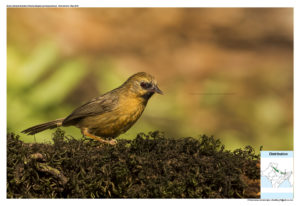Black-chinned Babbler

Black-chinned Babbler Stachyridopsis pyrrhops
Etymology:
- Stachyridopsis : Greek word stakhus -ear of wheat; rhis -nostrils;opsis- Appearance { reference to the shape of the opercula or scales almost closing the nostrils}
- Pyrrhops: Greek word purrhos -flame-coloured, red; ops –face { Red Face}
They belong to the family of Timaliidae Babblers
Distribution in India: Resident in Central Himalayas
Description: Size of 10 cm; wt. of 8–12 g. It is a dull biscuit-coloured babbler with red eye and blackish half-mask and chin. The crown is buffy grey with thin brown lines, shading on nape, upperparts, upperwing and tail are plain pale buff-grey. The lores to bill base and chin are black, supercilium, ear-coverts, submoustachial area, throat and underparts are buffy ocher, slightly duller on flanks. The iris is red; upper mandible is dark brown, lower mandible is flesh-coloured; legs are pale brownish-flesh. Both the sexes are similar. The juvenile is slightly less richly coloured than adult, black areas greyer.
Habitat: It is found in forest edge, open and secondary forest with low undergrowth, light forest, scrub-jungle, lantana thickets, bamboo, small nullahs and hedgerows. It is found between 245 m–2750 m
Food Habits: It eats Insects and berries. Found in association with other species, including other babblers, in mixed flocks. It usually forages close to or on ground.
Breeding Habits: They breed in Apr–Aug.The nest is a fairly deep cup or loose dome, made of dry grasses, dead leaves, woody stalks and plant fibers, lined with fibers, fine grasses, pine needles and black hair. They lay a clutch of 3-4 eggs.